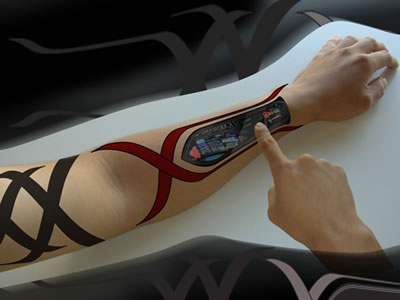Dattoos, DNA-based tattoos, create seamless connectivity and are the ultimate in personal technology. The Dattoo is, for now, a concept design by Hartmut Esslinger that uses the skin of the human body itself as hardware and network.

(Dattoo DNA-based personal technology)
Here are some details:
To achieve absolute personal identification, the hardware would capture DNA from the user’s body, enabling direct participation in the political and cultural landscape. The technology would link remote users through engagement with their areas of interest... Users view, test-drive, and select their product from a variety of options, both functional and aesthetic. They also set the lifecycle of the product, to be utilized for a few hours or a much longer amount of time. Once users are satisfied with their specific configurations, they have this fully-functioning circuitry - including all UI-interactive and display functions - “printed” onto recommended areas of their skin. Energy would be pulled from the human body to run the programs. At the end of the day, users would simply wash the Dattoos off, beginning anew the following day.Science fiction authors have already gone on ahead and imagined skinprint technology. In his 1984 novel Steel Beach, John Varley thinks about handwriters:
Call me old-fashioned. I'm the only reporter I know who still uses his handwriter except to take notes…I snapped the fingers of my left hand…Three rows of four colored dots appeared on the heel of my left hand. By pressing the dots in different combinations with my fingertips I was able to write the story in shorthand...Although this is a very far-fetched idea, the first steps have already been taken. IBM pioneered research in the area of using a living person's skin as a computer network in 1996 with a system that could successfully transmit data across skin at low speeds. Microsoft was granted a patent in 2004 for "a method and apparatus for transmitting power and data using the human body."
More recently, NTT has developed a technology called RedTacton, which can send data over the surface of human skin at speeds of up to 2Mbps -- the equivalent of a fast broadband data connection. The transmission is achieved by minutely modulating the electrical body field in the same way that a radio station wave is modulated to carry broadcast data.
And is it possible to print an electronic circuit with ink? Absolutely. Manufacturers already "print" RFID tags with a special "ink" that attracts metals in a special solution.
Practical applications? What if you could transfer images from your digital camera just by touching a pad on your PC? Or move music from your computer to the phone in your left hand - by touching the PC with your right? In a more intimate space, the girl you just met could transmit her phone number and other info with a handshake - or a kiss.


 6:25:00 AM
6:25:00 AM
 vicky
vicky

 Posted in:
Posted in: 

0 comments:
Post a Comment